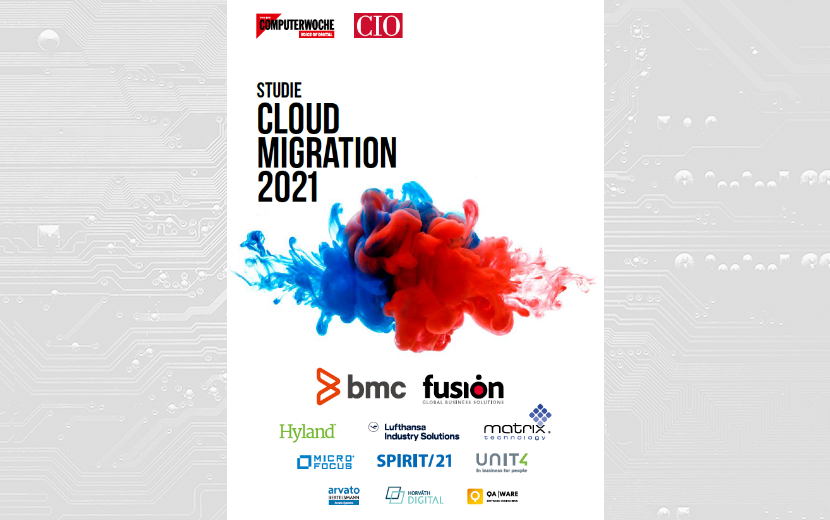The digital transformation is here and it’s gathering momentum. A key component of this is cloud migration. What initially seems like a simple shift of business processes, applications and data into the digital space is inevitably seen as a profound cultural change within a company. These changes do, indeed, offer sustainable opportunities, but they can also present security risks if the cloud strategy isn’t up to scratch.
The new “Cloud Migration” 2021 study from IDG
No cloud strategy without successful cloud migration
Of course, cloud migration doesn’t just happen overnight. As part of a cloud strategy, companies must evaluate their own requirements and question existing IT components, which is crucial for avoiding the potential pitfalls associated with cloud migration.
If you put in the necessary groundwork, you can soon expect to see real added value in the form of optimized processes and reduced costs. It is the IT decision-makers above all who feel the complex nature of cloud migration most. Indeed, they are the ones who shoulder the most responsibilities and, in most cases, they are also in charge of strategy development. However, since the effects are felt throughout the company, staff at management level should be more involved in the planning.
This study shows the role the cloud will play in the future, the challenges associated with migration and why a digital divide could still occur despite widespread investment.
The study contains:
- Detailed figures on how decision-makers and IT professionals from more than 360 companies rate the importance of cloud migration
- Explanations of the challenges and risks involved in migrating to the cloud
- An overview of suitable application areas for migration to cloud technologies
- Explanations and experiences of the possible cloud migration methods
- Criteria for selecting the appropriate cloud service provider
- Experiences of how quickly cloud migration can bring benefits
- The motivation and planning for cloud-to-cloud migrations
Find out in the study what importance high-ranking decision-makers attach to cloud strategies and the obstacles IT professionals in particular envisage in cloud migration.
The study was carried out by IDG Research Services in partnership with Lufthansa Industry Solutions in May 2021. 366 interviews were conducted; the companies surveyed came from various industries and varied in size and annual turnover.
The full results, as well as further assessments by and interviews with various experts, can be read in the complete study. The study is available to you free of charge. The following is a brief summary of some of the important findings and figures.
The "Hybrid Extension" is particularly popular
An essential part of cloud strategy is selecting the appropriate migration method. A large proportion (40 percent) opt for what’s known as ‘hybrid extension’ – a model in which local applications are moved to the cloud or extended with additional cloud functions.
34 percent opt for the ‘lift and shift’ method, i.e. direct migration without changing the code. Slightly under 17 percent are willing to go all in and have a full rebuild.
Complexity remains a challenge
Cloud migration constitutes a comprehensive project that has plenty of challenges and risks associated with it. Not only does the technical side play a role, but the migration itself is also a demanding task in terms of strategy and organization.
The companies surveyed cited complexity (32 percent) and a lack of support from management (26 percent) as potential stumbling blocks. The latter point in particular makes it clear that IT specialists would like to see greater involvement at business level.

Business intelligence and data analytics have high priority
When asked about the suitable application areas for a possible cloud migration, 34 percent gave business intelligence (BI) / data analytics as their answer. Almost as many companies see great potential in customer relationship management.
The differences according to company size are noteworthy. Only 27 percent of smaller companies with fewer than 500 employees (compared to 39 percent of large companies) see BI / data analytics as a suitable area of application.
A similar difference can be seen in IT security (20 percent among small companies, 34 percent among large ones).
External service providers remain relevant
Due to the challenging complexity associated with a cloud migration, almost two-thirds of companies bring in external service providers to perform the task. Only 27 percent carry out such projects on their own. In this case, 37 percent rely completely on an (external) service provider, while 26 percent outsource at least parts of the job to external parties. Given these figures, it’s all the more important to find reliable and competent providers that take each individual company’s own requirements into consideration to perform the migration.
Further study results on this and other topics can be found in the “Cloud Migration” IDG study 2021. This can be downloaded here, free of charge, in PDF format (only in German).





